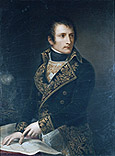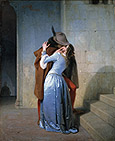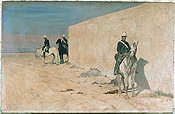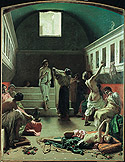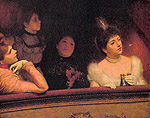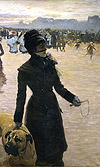The browser will either open the file, download it, or display a dialog.
| Please note: selected figures are viewable by clicking on the figure numbers which are hyperlinked. | ||||||
|
Ottocento: da Canova al Quarto Stato Catalogue: |
|||||
|
Nineteenth-century Italian art is a terrain that remains largely uncharted. Even within Italy, this most pivotal of centuries has yet to be afforded a comprehensive retrospective exhibition. This was amply remedied by Ottocento: da Canova al Quarto Stato, on view last spring at the Scuderie del Quirinale, Rome. Arranged chronologically over eleven rooms on two floors and exhibiting over 120 works this exhibition revealed both the surprising complexity of Italy and its arts during the long nineteenth century, and the extent to which so many artists and careers remain unexplored. |
||||||
|
Italy began the Ottocento rather ignominiously. By the end of the first decade, the peninsula had fallen to the French, for the second time if one considers Napoleon’s campaigns in the last years of the 1790s. Andrea Appiani’s 1803 Portrait of Napoleon Bonaparte, President of the Italian Republic in Room 1, is perhaps the most overt reflection of this martial history (fig. 1). However, the Scenes of living skeletons, in the same room and painted between 1802-1810 by Vincenzo Bonomini, better capture the spirit of the era (fig. 2, fig. 3, fig. 4). His group of canvases is simultaneously a burlesque rewriting of the memento mori, a sardonic reflection of Napoleonic Italy, and an utterly endearing inversion of expectation. Skeletons dressed in contemporary costume enact the events of the day. A military drummer musters the Italian Guardia Nazionale, a pair of married bourgeoisie parades on their land, and the artist himself, with his second wife and assistant in tow, works on a canvas depicting death. That these canvases were affixed to a catafalque used in annual remembrances of the dead at Bonomini’s parish church of Santa Grata in Borgo Canale a Bergamo only further complicates the work of an artist greatly overdue a closer examination. |
|||||
|
This first decade of the century poses critical questions about Neoclassicism. How does one perceive an Italian Neoclassicism, an idiom that, unlike its foreign counterparts, maintains an immediate geographic proximity to and, arguably, a continuous historical tradition with its sources? One cannot help but wonder what happens when the Italian example is prioritized over its French, English, or German counterparts, or to what extent Neoclassicism is inherently an Italian phenomenon. Perhaps a more meaningful inquiry would consider Neoclassicism apart from the realm of national identity. Italy, after all, was not yet a nation. |
||||||
|
The following decades would witness a series of important shifts. Napoleon’s 1814 fall was followed, in 1822, by the death of Canova, an event that signaled the wane of the Neoclassical idiom. Concurrently, the emergence of Pietro Tenerani and Francesco Hayez, both seen first in Room 2, signal new dispositions for sculpture and painting, respectively. Works like Tenerani’s sculpture Psyche abandoned, 1816, add a new introspective subtlety and psychological empathy (fig. 5). This is an image of the work in the collection of the Florence Galleria d’Arte Moderna, 1819. The work in the show is the 1816 model, in the Collezione Matarazzo di Licosa. Hayez, in works like The Lampugnani conspiracy of 1826-29, recasts history painting, modernizing the treatment of historical subject matters and mobilizing these as parallels to the specific contexts of his own contemporary Italy (fig. 6). |
||||||
|
After this period of post-Napoleonic transition, there is a flourishing of both languages and genres. Giovanni Andrea Carnovali (Il Piccio) darts between classical mythologies, aristocratic portraiture, and religious altarpieces with an exuberant brushwork and subtle, middle-range palette that synthesize a bounty of previous innovations, both native and foreign. Giuseppe Molteni’s Harem Slave of 1838 (Room 4) is arguably the most refined beauty in the exhibition, calling to mind the grace and classical perfection of Domenichino and Guido Reni, reminding us again that Italian painting is always engaged in conversation with itself. This continues in Luigi Mussini’s 1855 Eudoro and Cimodoce, the purist rigor of which bears a certain resemblance to the seicento Emilian Bartolomeo Schedoni, as does Domenico Morelli’s 1855 The Iconoclasts to the earthen, leather-skinned workers of Agostino and Lodovico Carracci. That both groups, separated by over two centuries, were participant in the reconciliation of the classical with the naturalistic only enriches these idiomatic kinships. |
||||||
|
Perhaps most exciting about this middle span of the century is the forceful emergence of landscape painting, displayed in Room 2. Giuseppe Pietro Bagetti’s c. 1820-30 Nocturne with the effect of the moon speaks of the same vast solitude as Caspar David Friedrich, though more quietly. Others, including Marco Gozzi, Giovanni Migliara, Luigi Basiletti, Giuseppe Canella, Giacinto Gigante, and Angelo Inganni depict the Italian countryside, its occupants, and their habits as if to verify and preserve the presence of an indigenous culture in the face of years of foreign occupation. Perhaps retrospectively, one senses a desire for the native Italian that anticipates events to come. Among these remarkably diverse and consistent landscape artists, Ippolito Caffi stands supreme. His 1840-49 Venice-Snow and fog (Snow and fog on the Grand Canal/Grand Canal covered with snow and ice) is as potent an image of the city as that produced by any vedutista, prior or hence, and his depiction of the Roman Colosseum reveals the monument in an unexpectedly demure moment, more a repoussoir for the Roman campagna than the domineering urban behemoth we have come to expect. |
||||||
|
Towards the end of the first floor, things become significantly more familiar. Hayez, still a central figure, very sweetly ushers in the age of Garibaldi with his 1859 The Kiss (fig. 7). Continuing into the final room of the first floor and throughout nearly the entirety of the second floor, we are swept away amidst Italy’s entrance into Modern Europe. Unification emerges as a constant theme, in works such as Gerolamo Induno’s 1860 Embarkation of Garibaldi at Quarto and Odoardo Borrani’s 1863 Seamstresses of the Red Shirts (fig. 8, fig. 9). |
||||||
|
From this point forward, the exhibition is a cornucopia of Italy’s most famous nineteenth-century paintings. Naturally, the Macchiaioli dominate with their most recognizable works on display. Giovanni Fattori’s 1872 The Look-Out (fig. 10) is as stark and profoundly groundbreaking as one would hope, and Silvestro Lega’s 1873 The last moments of the dying Mazzini is even more solemn and arresting than expected. These, steps away from works such as Giovanni Boldini’s 1866 Giovanni Fattori in his studio (L'atelier d'un peintre) (fig. 11) and Domenico Morelli’s 1861 Pompeian Bath (fig. 12) make quite the case for this era of Italian painting, as do the works of Giovanni Costa, Tranquillo Cremona, Federico Faruffini, Federico Zandomeneghi (fig. 13), and De Nittis (fig. 14) nearby. Certainly, these artists are not as omnipresent as their French contemporaries. However, this exhibition clearly demonstrates that they are as formidable and diverse. |
||||||
|
The emergence of Gaetano Previati at century’s end signals a point of departure. Not only is his 1890-91 Maternity (fig. 15) the first work one encounters in the exhibition, at the foot of the entrance stair (followed immediately by Pellizza da Volpedo’s 1901 The Fourth Estate (fig. 16) and Canova’s 1795-1806 Pugilists in a profoundly satisfying trifecta), but his works on display in the final room of the exhibition reveal his new approach to form and rendering, later absorbed by the young Futurists before being revolutionized into Italy’s first twentieth-century avant-garde. The juxtaposition of his work with that of Medardo Rosso, Emilio Longoni, Antonio Mancini, and Giulio Aristide Sartorio, to say little of Longoni’s magnificent Glacier of 1905, reveals not only how modern Italian painting was becoming, but also how deeply indebted to tradition it still remained (fig. 17). This is the paradox of Ottocento painting, a paradox inherited from the Renaissance and passed on to subsequent generations. |
||||||
|
The catalog for Ottocento: Da Canova al Quarto Stato quite nobly seeks to disentangle this Gordion Knot. Its three essays, Fernando Mazzocca on the period from Napoleon to Unification, Carlo Sisi on the years from Unification to the end of the century, and Maria Vittoria Marini Clarelli’s essay on exhibitions and the public in nineteenth-century Italy, do much to illuminate the century. Due, however, to the limitations of length of an exhibition catalog, and the necessities of writing for a general audience, none of these essays is able to delve very deeply into its subject matter. Thankfully, each work in the exhibition is afforded a full-page interpretive essay. These, along with Anna Villari’s “Cultural Chronology” do most of the heavy lifting, as do the thorough bibliography and exhibition history. These latter sections, unfortunately, are arranged alphabetically by author and location, which does much to confound those who do not already know exactly what they seek. Nevertheless, this catalog offers an excellent introduction to the century and should become a staple in any library that seeks to cover the subject. |
||||||
|
Ultimately, Ottocento: Da Canova al Quarto Stato and its catalog do much to remedy the unfortunate obscurity of much of nineteenth-century Italian art. But its greatest success is that it compels us to look again and anew not only at nineteenth-century Italian art, but also the entire century, as well as those before and after. |
||||||
|
Adrian R. Duran |
||||||


